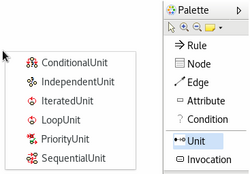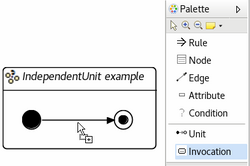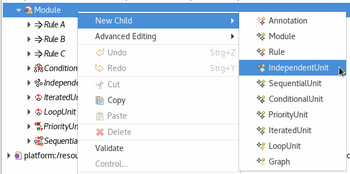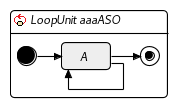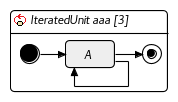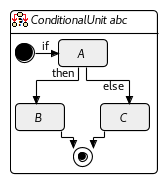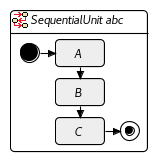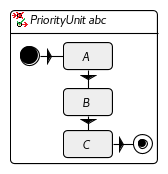Notice: This Wiki is now read only and edits are no longer possible. Please see: https://gitlab.eclipse.org/eclipsefdn/helpdesk/-/wikis/Wiki-shutdown-plan for the plan.
Henshin/Units
In Henshin, control flow is specified using units.
Units have a fixed number of sub-units, allowing for arbitrary nesting.
This article describes the available units.
Units can be categorized by their possible number of sub-units. For unary units the number of sub-units is exactly one. Multi-units have an arbitrary number of sub-units. The specific unit Conditional Unit has two or three sub-units.
Each unit checks the executability of at least one sub-unit, if a sub-unit exists. This check means the sub-unit is executed.
Contents
Usage
Unit creation in graphical editor
To add a unit to a Henshin project in the graphical editor, first open the *.henshin_diagram file. Then select Unit from the Palette on the right of the window. Afterwards left-click any empty space of the Henshin diagram and choose the desired unit from the appearing menu.
If the selected unit is a Multi-Unit, some sub-units have to be added manually. Therefore select Invocation from the Palette and click on the according Multi-Unit. Then type the name of the desired rule or unit. Currently every sub-unit is inserted behind all existing sub-units, which is especially relevant for PriorityUnits and SequentialUnits. If that's not the desired behaviour it is recommended to use the Properties view or the tree-based editor for sub-unit insertion or reordering.
Unit creation in tree-based editor
To add a unit to a Henshin project in the tree-based editor, first open the *.henshin file. Then right-click on the parent Module. Select New Child and afterwards the desired unit from the context menu. After creation the units can be edited in their Properties view.
Unary Units
A Unary Unit has exactly one sub-unit.
Loop Unit
- Number of sub-units: 1
- Available Flags/Properties: none
- Execution successful: always
- Control flow: The sub-unit is executed as often as it is executable.
- Examples: Java2StateMachine, Ecore2GenModel
Iterated Unit
- Number of sub-units: 1
- Available Flags/Properties: iterations (integer), strict, rollback (both of type boolean)
- Execution successful if:
- strict=true: all iterations successful
- strict=false: at least one iteration successful
- Control flow: The sub-unit is executed as often as specified in the iterations property.
- strict=false, rollback=true/false: If one of the iterations cannot be executed, the next iteration is executed. As the execution never stops, the rollback flag has no effect.
- strict=true, rollback=false: If one of the iterations cannot be executed, the execution stops.
- strict=true, rollback=true: If one of the iterations cannot be executed, the execution stops and previous executions are reverted.
- Examples: Grid and Comb Pattern
Conditional Unit
- Number of sub-units: 2 or 3
- Available Flags/Properties: none
- Execution successful if: if unit and then unit are successful or if unit is unsuccessful while else unit is successful or not present.
- Control flow: If a match for the if unit can be found, the then unit is executed. Otherwise, if present, the else unit is executed.
- Examples: Java2StateMachine
Multi-Units
A Multi-Unit has an arbitrary number of sub-units.
Sequential Unit
- Number of sub-units: arbitrary (0..*)
- Available Flags/Properties: strict, rollback (both of type boolean)
- Execution successful if:
- strict=true: all sub-units successful or no sub-units existing
- strict=false: at least one sub-unit successful or no sub-units existing
- Control flow: The sub-units are executed in the given order.
- strict=false: If one of the sub-units cannot be executed, the next sub-unit is executed. As the execution never stops, the rollback flag has no effect.
- strict=true, rollback=false: If one of the sub-units cannot be executed, the execution stops.
- strict=true, rollback=true: If one of the sub-units cannot be executed, the execution stops and previous executions are reverted.
- Examples: Ecore2RDB, Java2StateMachine, Ecore2GenModel, Grid and Comb Pattern, Movies
Priority Unit
- Number of sub-units: arbitrary (0..*)
- Available Flags/Properties: none
- Execution successful if: one sub-unit successful (Empty priority units always fail.)
- Control flow: The sub-units are checked in the given order for executability. The first sub-unit found to be executable is executed.
- Examples: Java2StateMachine
Independent Unit
- Number of sub-units: arbitrary (0..*)
- Available Flags/Properties: none
- Execution successful: one sub-unit succesful (Empty independent units always fail.)
- Control flow: The sub-units are checked in nondeterministic order for executability. The first sub-unit found to be executable is executed.
- Examples: Ecore2GenModel

